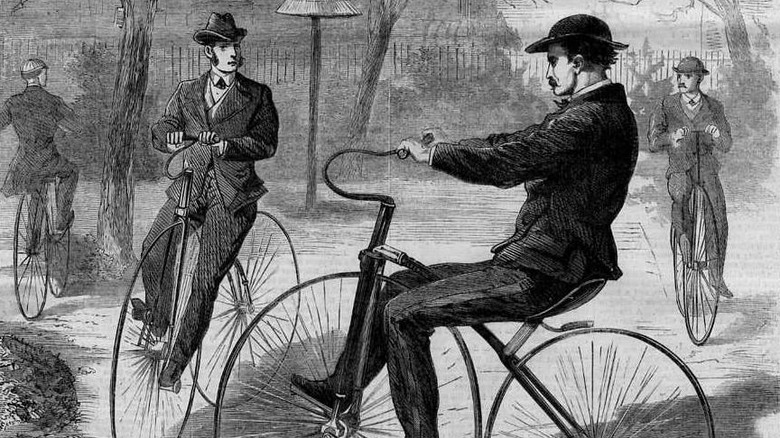How 19th Century Doctors Made Up An Illness To Scare Women Away From Bicycling
Now, there are many more dangerous modes of transport than bicycles. Throwing a saddle over an untamed stallion and trying to ride it to work may be one to avoid, for instance. Nevertheless, the perils of pushbikes and motorcycles alike are well known. There's just no getting away from the fact that protection is far more meager for a cyclist than a driver.
In the paper "Comparing the fatality risks in United States transportation across modes and over time" (per Research In Transportation Economics), author Ian Savage determined that the rate of passenger fatalities per billion miles traveled was a staggering 212.57 on a motorcycle, with the second-highest number being just 7.28 for those traveling in a car or truck. Two wheels, then, are more perilous than one. A lot more.
In the 19th century, however, there was a different danger to be aware of while riding a bicycle. An utterly ridiculous illness that was entirely fictional, fabricated by doctors.
As Britannica reports, the precursor to the bicycle as we know it today was the velocipede. It was not a frightening kind of dinosaur and insect hybrid, but a framework of iron featuring wheels with wooden spokes. It emerged in France, and in the late 1860s, refinements to the machine (including rubber tires) started to be developed just as it took off in the United States.
What was bicycle face?
More developments of the so-called ordinary bicycle were spearheaded by one British James Starley, Britannica goes on. He created the Ariel, a new standard in cycling comfort, in 1871. British bicycles began to be sold in the United States in 1876, following a showcase of them at the Philadelphia Centennial Exposition, and the U.S. was soon producing its own. The joy of bicycling was spreading, and so, naturally, was opposition to it.
As we know today, cycling is an excellent and environmentally-friendly form of transport, and a valuable source of exercise. Some doctors at the close of the 19th century, however, were keen to turn people away from this new phenomenon, alleging that cycling can cause a silly fictional condition they called "bicycle face."
On September 7, 1895, the Literary Digest published an article detailing this supposed malady. It began, "warning against excessive indulgence in 'wheeling' will perhaps be heeded more on account of the discovery of the alleged "bicycle face" by English medical papers."
"A wearied and exhausted 'bicycle face,'" the outlet went on, was said to be caused by "over-exertion, the upright position on the wheel and the unconscious effort to maintain one's balance." Though the Literary Digest admits that some cyclists were quick to dismiss this claim, it continued to be made.
I am woman, hear me cycle
Some deemed "bicycle face" to be a condition that would gradually disappear if the velocipede was dispensed with, while others believed the supposed symptoms would remain forever, as Vox states. Predictably, though, it seemed women were considered particularly susceptible.
Janet M. Davis' "The Circus Age: Culture & Society Under the American Big Top" provides some interesting insight into why this may have been. According to Davis, doctors generally approved of the physical fitness bicycles offered, though there were some who believed that cycling was very dangerous, and that the bumpy ride could even displace the uterus. Davis goes on to state that "bicycle saddles reportedly allowed women to masturbate while riding, thereby reducing procreative desire."
Vox adds that the popularity of bicycles would have naturally contributed to a need for less restrictive clothing, so as to allow people to cycle more freely. In short, women were taking great, crucial strides — well, they were cycling, but figuratively striding — away from the concept of solely being homemakers, and this was quite a threat to the antiquated world views many held at the time. This threat seemed to manifest itself in the absurd notion of "bicycle face."


